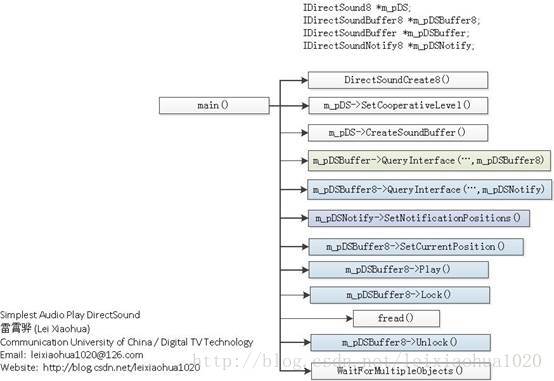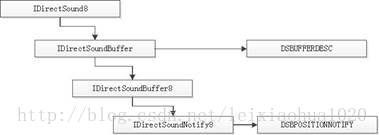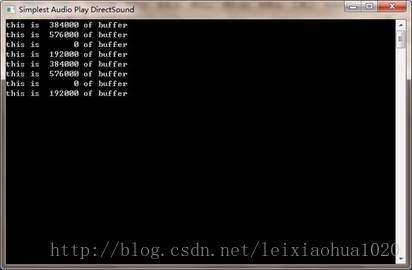最簡單的視音頻播放示例8:DirectSound播放PCM
來源:程序員人生 發(fā)布時間:2014-11-04 08:54:08 閱讀次數:3566次
本文記錄DirectSound播放音頻的技術。DirectSound是Windows下最多見的音頻播放技術。目前大部份的音頻播放利用都是通過DirectSound來播放的。本文記錄1個使用DirectSound播放PCM的例子。
注:1位仁兄已提示我DirectSound已計劃被XAudio2取代了。后來考證了1下發(fā)現確有此事。因此在下次更新中斟酌加入XAudio2播放PCM的例子。本文依然記錄1下DirectSound這位“元老”。

DirectSound簡介
DirectSound是微軟所開發(fā)DirectX的組件之1,可以在Windows 操作系統(tǒng)上錄音,并且記錄波形音效(waveform sound)。目前DirectSound 是1個成熟的API ,提供許多有用的功能,例如能夠在較高的分辨率播放多聲道聲音。
DirectSound3D(DS3D)最早是1993年與 DirectX 3 1起發(fā)表的。DirectX 8以后的DirectSound和DirectSound3D的(DS3D)被合稱DirectX Audio。
DirectSound有以下幾種對象:
對象 | 數量 | 作用 | 主要接口 |
裝備 | 每一個利用程序只有1個裝備對象 | 用來管理裝備,創(chuàng)建輔助緩沖區(qū) | IDirectSound8 |
輔助緩沖區(qū) | 每個聲音對應1個輔助緩沖區(qū) | 用來管理1個靜態(tài)的或動態(tài)的聲音流,然后在主緩沖區(qū)中混音 | IDirectSoundBuffer8, IDirectSound3DBuffer8, IDirectSoundNotify8 |
主緩沖區(qū) | 1個利用程序只有1個主緩沖區(qū) | 將輔助緩沖區(qū)的數據進行混音,并且控制3D參數. | IDirectSoundBuffer, IDirectSound3DListener8 |
DirectSound播放音頻的流程
使用DirectSound播放音頻1般情況下需要以下步驟:
1.
初始化
1) 創(chuàng)建1個IDirectSound8接口的對象
2) 設置協作級
3) 創(chuàng)建1個主緩沖對象
4) 創(chuàng)建1個副緩沖對象
5) 創(chuàng)建通知對象
6) 設置通知位置
7) 開始播放
2.
循環(huán)播放聲音
1) 數據填充至副緩沖區(qū)
2) 等待播放完成
下面結合詳細分析1下上文的流程。
1. 初始化
1) 創(chuàng)建1個IDirectSound8接口的對象通過DirectSoundCreate8()方法可以創(chuàng)建1個裝備對象。這個對象通常代表缺省的播放裝備。DirectSoundCreate8()函數定義以下。
HRESULT DirectSoundCreate8(
LPCGUID lpcGuidDevice,
LPDIRECTSOUND8 * ppDS8,
LPUNKNOWN pUnkOuter
)
參數的含義以下:
lpcGuidDevice:要創(chuàng)建的裝備對象的GUID。可以指定為NULL,代表默許的播放裝備。
ppDS8:返回的IDirectSound8對象的地址。
pUnkOuter:必須設為NULL。
例如以下代碼便可創(chuàng)建1個IDirectSound8接口的對象
IDirectSound8 *m_pDS=NULL;
DirectSoundCreate8(NULL,&m_pDS,NULL);
2) 設置協作級Windows 是1個多任務環(huán)境,同1時間有多個利用程序去訪問裝備。通過使用協作級別,DirectSound可以確保利用程序不會在別的裝備使用時去訪問,每一個 DirectSound利用程序都有1個協作級別,這個級別決定著訪問硬件的權限。
在創(chuàng)建1個裝備對象以后,必須通過用IDirectSound8的SetCooperativeLevel()設置協作權限,否則將聽不到聲音。SetCooperativeLevel()的定義以下
HRESULT SetCooperativeLevel(
HWND hwnd,
DWORD dwLevel
)
參數的含義以下:
hwnd:利用程序窗口句柄。
dwLevel:支持以下幾種級別。
DSSCL_EXCLUSIVE:與DSSCL_PRIORITY具有相同的作用。
DSSCL_NORMAL:正常的調和層級標志,其他程序可同享聲卡裝備進行播放。
DSSCL_PRIORITY:設置聲卡裝備為當前程序獨占。
DSSCL_WRITEPRIMAR:可寫主緩沖區(qū),此時副緩沖區(qū)就不能進行播放處理,即不能將次緩沖區(qū)的數據送進混聲器,再輸出到主緩沖區(qū)上。這是最完全控制聲音播放的方式。
3) 創(chuàng)建1個主緩沖對象使用IDirectSound8的CreateSoundBuffer()可以創(chuàng)建1個IDirectSoundBuffer接口的主緩沖區(qū)對象。CreateSoundBuffer()的定義以下。
HRESULT CreateSoundBuffer(
LPCDSBUFFERDESC pcDSBufferDesc,
LPDIRECTSOUNDBUFFER * ppDSBuffer,
LPUNKNOWN pUnkOuter
)
參數的含義以下:
pcDSBufferDesc:描寫聲音緩沖的DSBUFFERDESC結構體的地址
ppDSBuffer:返回的IDirectSoundBuffer接口的對象的地址。
pUnkOuter:必須設置為NULL。
其中觸及到1個描寫聲音緩沖的結構體DSBUFFERDESC,該結構體的定義以下:
typedef struct _DSBUFFERDESC
{
DWORD dwSize;
DWORD dwFlags;
DWORD dwBufferBytes;
DWORD dwReserved;
LPWAVEFORMATEX lpwfxFormat;
} DSBUFFERDESC
簡單解釋1下其中的變量的含義:
dwSize:結構體的大小。必須初始化該值。
dwFlags:設置聲音緩存的屬性。有很多選項,可以組合使用,就不逐一列出了。詳細的參數可以查看文檔。
dwBufferBytes:緩沖的大小。
dwReserved:保存參數,暫時沒有用。
lpwfxFormat:指向1個WAVE格式文件頭的指針。
設置DSBUFFERDESC終了后,就能夠使用CreateSoundBuffer()創(chuàng)建主緩沖了。示例代碼以下:
DSBUFFERDESC dsbd;
memset(&dsbd,0,sizeof(dsbd));
dsbd.dwSize=sizeof(dsbd);
dsbd.dwFlags=DSBCAPS_GLOBALFOCUS | DSBCAPS_CTRLPOSITIONNOTIFY |DSBCAPS_GETCURRENTPOSITION2;
dsbd.dwBufferBytes=MAX_AUDIO_BUF*BUFFERNOTIFYSIZE;
//WAVE Header
dsbd.lpwfxFormat=(WAVEFORMATEX*)malloc(sizeof(WAVEFORMATEX));
dsbd.lpwfxFormat->wFormatTag=WAVE_FORMAT_PCM;
/* format type */
(dsbd.lpwfxFormat)->nChannels=channels;
/* number of channels (i.e. mono, stereo...) */
(dsbd.lpwfxFormat)->nSamplesPerSec=sample_rate;
/* sample rate */
(dsbd.lpwfxFormat)->nAvgBytesPerSec=sample_rate*(bits_per_sample/8)*channels;
/* for buffer estimation */
(dsbd.lpwfxFormat)->nBlockAlign=(bits_per_sample/8)*channels;
/* block size of data */
(dsbd.lpwfxFormat)->wBitsPerSample=bits_per_sample;
/* number of bits per sample of mono data */
(dsbd.lpwfxFormat)->cbSize=0;
//Creates a sound buffer object to manage audio samples.
HRESULT hr1;
if( FAILED(m_pDS->CreateSoundBuffer(&dsbd,&m_pDSBuffer,NULL))){
return FALSE;
}
4) 創(chuàng)建1個副緩沖對象使用IDirectSoundBuffer的QueryInterface()可以得到1個IDirectSoundBuffer8接口的對象。IDirectSoundBuffer8的GUID為IID_IDirectSoundBuffer8。示例代碼以下。
IDirectSoundBuffer *m_pDSBuffer=NULL;
IDirectSoundBuffer8 *m_pDSBuffer8=NULL;
...
if( FAILED(m_pDSBuffer->QueryInterface(IID_IDirectSoundBuffer8,(LPVOID*)&m_pDSBuffer8))){
return FALSE ;
}
5) 創(chuàng)建通知對象使用IDirectSoundBuffer8的QueryInterface()可以得到1個IDirectSoundNotify8接口的對象。IDirectSoundBuffer8的GUID為IID_IDirectSoundNotify。示例代碼以下。
IDirectSoundBuffer8 *m_pDSBuffer8=NULL;
IDirectSoundNotify8 *m_pDSNotify=NULL;
…
if(FAILED(m_pDSBuffer8->QueryInterface(IID_IDirectSoundNotify,(LPVOID*)&m_pDSNotify))){
return FALSE ;
}
1句話概括1下通知對象的作用:當DirectSound緩沖區(qū)中的數據播放終了后,告知系統(tǒng)應當填充新的數據。
6) 設置通知位置使用IDirectSoundNotify8的SetNotificationPositions()可以設置通知的位置。SetNotificationPositions()的定義以下。
HRESULT SetNotificationPositions(
DWORD dwPositionNotifies,
LPCDSBPOSITIONNOTIFY pcPositionNotifies
)
參數含義以下。
dwPositionNotifies:DSBPOSITIONNOTIFY結構體的數量。既包括幾個通知的位置。
pcPositionNotifies:指向DSBPOSITIONNOTIFY結構體數組的指針。
再這里觸及到1個結構體DSBPOSITIONNOTIFY,它描寫了通知的位置。DSBPOSITIONNOTIFY的定義以下。
typedef struct DSBPOSITIONNOTIFY {
DWORD dwOffset;
HANDLE hEventNotify;
} DSBPOSITIONNOTIFY;
它的成員的含義以下。
dwOffset:通知事件觸發(fā)的位置(距離緩沖開始位置的偏移量)。
hEventNotify:觸發(fā)的事件的句柄。
7) 開始播放使用IDirectSoundBuffer8的SetCurrentPosition ()可以設置播放的位置。SetCurrentPosition ()定義以下
HRESULT SetCurrentPosition(
DWORD dwNewPosition
)
其中dwNewPosition是播放點與緩沖區(qū)首個字節(jié)之間的偏移量。
使用IDirectSoundBuffer8的Play ()可以開始播放音頻數據。Play ()定義以下。
HRESULT Play(
DWORD dwReserved1,
DWORD dwPriority,
DWORD dwFlags
)
參數含義:
dwReserved1:保存參數,必須取0。
dwPriority:優(yōu)先級,1般情況下取0便可。
dwFlags:標志位。目前常見的是DSBPLAY_LOOPING。當播放至緩沖區(qū)結尾的時候,重新從緩沖區(qū)開始處開始播放。
2. 循環(huán)播放聲音
1) 數據填充至副緩沖區(qū)數據填充至副緩沖區(qū)之前,需要先使用Lock()鎖定緩沖區(qū)。然后就能夠使用fread(),memcpy()等方法將PCM音頻采樣數據填充至緩沖區(qū)。數據填充終了后,使用Unlock()取消對緩沖區(qū)的鎖定。
Lock()函數的定義以下。
HRESULT Lock(
DWORD dwOffset,
DWORD dwBytes,
LPVOID * ppvAudioPtr1,
LPDWORD pdwAudioBytes1,
LPVOID * ppvAudioPtr2,
LPDWORD pdwAudioBytes2,
DWORD dwFlags
)
參數的含義以下。
dwOffset:鎖定的內存與緩沖區(qū)首地址之間的偏移量。
dwBytes:鎖定的緩存的大小。
ppvAudioPtr1:獲得到的指向緩存數據的指針。
pdwAudioBytes1:獲得到的緩存數據的大小。
ppvAudioPtr2:沒有用到,設置為NULL。
pdwAudioBytes2:沒有用到,設置為0。
dwFlags:暫時沒有研究。
UnLock()函數的定義以下。
HRESULT Unlock(
LPVOID pvAudioPtr1,
DWORD dwAudioBytes1,
LPVOID pvAudioPtr2,
DWORD dwAudioBytes2
)
參數含義以下。
pvAudioPtr1:通過Lock()獲得到的指向緩存數據的指針。
dwAudioBytes1:寫入的數據量。
pvAudioPtr2:沒有用到。
dwAudioBytes2:沒有用到。
2) 等待播放完成
根據此前設置的通知機制,使用WaitForMultipleObjects()等待緩沖區(qū)中的數據播放終了,然落后入下1個循環(huán)。
播放音頻流程總結
DirectSound播放PCM音頻數據的流程以下圖所示。
其中觸及到的幾個結構體之間的關系以下圖所示。
代碼
貼上源代碼。
/**
* 最簡單的DirectSound播放音頻的例子(DirectSound播放PCM)
* Simplest Audio Play DirectSound (DirectSound play PCM)
*
* 雷霄驊 Lei Xiaohua
* leixiaohua1020@126.com
* 中國傳媒大學/數字電視技術
* Communication University of China / Digital TV Technology
* http://blog.csdn.net/leixiaohua1020
*
* 本程序使用DirectSound播放PCM音頻采樣數據。
* 是最簡單的DirectSound播放音頻的教程。
*
* 函數調用步驟以下:
*
* [初始化]
* DirectSoundCreate8(): 創(chuàng)建1個DirectSound對象。
* SetCooperativeLevel(): 設置協作權限,不然沒有聲音。
* IDirectSound8->CreateSoundBuffer(): 創(chuàng)建1個主緩沖區(qū)對象。
* IDirectSoundBuffer->QueryInterface(IID_IDirectSoundBuffer8..):
* 創(chuàng)建1個副緩沖區(qū)對象,用來存儲要播放的聲音數據文件。
* IDirectSoundBuffer8->QueryInterface(IID_IDirectSoundNotify..):
* 創(chuàng)建通知對象,通知利用程序指定播放位置已到達。
* IDirectSoundNotify8->SetNotificationPositions(): 設置通知位置。
* IDirectSoundBuffer8->SetCurrentPosition(): 設置播放的起始點。
* IDirectSoundBuffer8->Play(): 開始播放。
*
* [循環(huán)播放數據]
* IDirectSoundBuffer8->Lock(): 鎖定副緩沖區(qū),準備寫入數據。
* fread(): 讀取數據。
* IDirectSoundBuffer8->Unlock(): 解鎖副緩沖區(qū)。
* WaitForMultipleObjects(): 等待“播放位置已到達”的通知。
*
* This software plays PCM raw audio data using DirectSound.
* It's the simplest tutorial about DirectSound.
*
* The process is shown as follows:
*
* [Init]
* DirectSoundCreate8(): Init DirectSound object.
* SetCooperativeLevel(): Must set, or we won't hear sound.
* IDirectSound8->CreateSoundBuffer(): Create primary sound buffer.
* IDirectSoundBuffer->QueryInterface(IID_IDirectSoundBuffer8..):
* Create secondary sound buffer.
* IDirectSoundBuffer8->QueryInterface(IID_IDirectSoundNotify..):
* Create Notification object.
* IDirectSoundNotify8->SetNotificationPositions():
* Set Notification Positions.
* IDirectSoundBuffer8->SetCurrentPosition(): Set position to start.
* IDirectSoundBuffer8->Play(): Begin to play.
*
* [Loop to play data]
* IDirectSoundBuffer8->Lock(): Lock secondary buffer.
* fread(): get PCM data.
* IDirectSoundBuffer8->Unlock(): UnLock secondary buffer.
* WaitForMultipleObjects(): Wait for Notifications.
*/
#include <stdio.h>
#include <stdlib.h>
#include <windows.h>
#include <dsound.h>
#define MAX_AUDIO_BUF 4
#define BUFFERNOTIFYSIZE 192000
int sample_rate=44100; //PCM sample rate
int channels=2; //PCM channel number
int bits_per_sample=16; //bits per sample
BOOL main(int argc,char * argv[])
{
int i;
FILE * fp;
if((fp=fopen("../NocturneNo2inEflat_44.1k_s16le.pcm","rb"))==NULL){
printf("cannot open this file
");
return ⑴;
}
IDirectSound8 *m_pDS=NULL;
IDirectSoundBuffer8 *m_pDSBuffer8=NULL; //used to manage sound buffers.
IDirectSoundBuffer *m_pDSBuffer=NULL;
IDirectSoundNotify8 *m_pDSNotify=NULL;
DSBPOSITIONNOTIFY m_pDSPosNotify[MAX_AUDIO_BUF];
HANDLE m_event[MAX_AUDIO_BUF];
SetConsoleTitle(TEXT("Simplest Audio Play DirectSound"));//Console Title
//Init DirectSound
if(FAILED(DirectSoundCreate8(NULL,&m_pDS,NULL)))
return FALSE;
if(FAILED(m_pDS->SetCooperativeLevel(FindWindow(NULL,TEXT("Simplest Audio Play DirectSound")),DSSCL_NORMAL)))
return FALSE;
DSBUFFERDESC dsbd;
memset(&dsbd,0,sizeof(dsbd));
dsbd.dwSize=sizeof(dsbd);
dsbd.dwFlags=DSBCAPS_GLOBALFOCUS | DSBCAPS_CTRLPOSITIONNOTIFY |DSBCAPS_GETCURRENTPOSITION2;
dsbd.dwBufferBytes=MAX_AUDIO_BUF*BUFFERNOTIFYSIZE;
//WAVE Header
dsbd.lpwfxFormat=(WAVEFORMATEX*)malloc(sizeof(WAVEFORMATEX));
dsbd.lpwfxFormat->wFormatTag=WAVE_FORMAT_PCM;
/* format type */
(dsbd.lpwfxFormat)->nChannels=channels;
/* number of channels (i.e. mono, stereo...) */
(dsbd.lpwfxFormat)->nSamplesPerSec=sample_rate;
/* sample rate */
(dsbd.lpwfxFormat)->nAvgBytesPerSec=sample_rate*(bits_per_sample/8)*channels;
/* for buffer estimation */
(dsbd.lpwfxFormat)->nBlockAlign=(bits_per_sample/8)*channels;
/* block size of data */
(dsbd.lpwfxFormat)->wBitsPerSample=bits_per_sample;
/* number of bits per sample of mono data */
(dsbd.lpwfxFormat)->cbSize=0;
//Creates a sound buffer object to manage audio samples.
HRESULT hr1;
if( FAILED(m_pDS->CreateSoundBuffer(&dsbd,&m_pDSBuffer,NULL))){
return FALSE;
}
if( FAILED(m_pDSBuffer->QueryInterface(IID_IDirectSoundBuffer8,(LPVOID*)&m_pDSBuffer8))){
return FALSE ;
}
//Get IDirectSoundNotify8
if(FAILED(m_pDSBuffer8->QueryInterface(IID_IDirectSoundNotify,(LPVOID*)&m_pDSNotify))){
return FALSE ;
}
for(i =0;i<MAX_AUDIO_BUF;i++){
m_pDSPosNotify[i].dwOffset =i*BUFFERNOTIFYSIZE;
m_event[i]=::CreateEvent(NULL,false,false,NULL);
m_pDSPosNotify[i].hEventNotify=m_event[i];
}
m_pDSNotify->SetNotificationPositions(MAX_AUDIO_BUF,m_pDSPosNotify);
m_pDSNotify->Release();
//Start Playing
BOOL isPlaying =TRUE;
LPVOID buf=NULL;
DWORD buf_len=0;
DWORD res=WAIT_OBJECT_0;
DWORD offset=BUFFERNOTIFYSIZE;
m_pDSBuffer8->SetCurrentPosition(0);
m_pDSBuffer8->Play(0,0,DSBPLAY_LOOPING);
//Loop
while(isPlaying){
if((res >=WAIT_OBJECT_0)&&(res <=WAIT_OBJECT_0+3)){
m_pDSBuffer8->Lock(offset,BUFFERNOTIFYSIZE,&buf,&buf_len,NULL,NULL,0);
if(fread(buf,1,buf_len,fp)!=buf_len){
//File End
//Loop:
fseek(fp, 0, SEEK_SET);
fread(buf,1,buf_len,fp);
//Close:
//isPlaying=0;
}
m_pDSBuffer8->Unlock(buf,buf_len,NULL,0);
offset+=buf_len;
offset %= (BUFFERNOTIFYSIZE * MAX_AUDIO_BUF);
printf("this is %7d of buffer
",offset);
}
res = WaitForMultipleObjects (MAX_AUDIO_BUF, m_event, FALSE, INFINITE);
}
return 0;
}
運行結果
代碼運行以后,會彈出1個“控制臺”對話框以下圖所示。同時音頻裝備里面可以聽到播放的聲音。
下載
代碼位于“Simplest Media Play”中
SourceForge項目地址:https://sourceforge.net/projects/simplestmediaplay/
CSDN下載地址:http://download.csdn.net/detail/leixiaohua1020/8054395
上述工程包括了使用各種API(Direct3D,OpenGL,GDI,DirectSound,SDL2)播放多媒體例子。其中音頻輸入為PCM采樣數據。輸出至系統(tǒng)的聲卡播放出來。視頻輸入為YUV/RGB像素數據。輸出至顯示器上的1個窗口播放出來。
通過本工程的代碼初學者可以快速學習使用這幾個API播放視頻和音頻的技術。
1共包括了以下幾個子工程:
simplest_audio_play_directsound: 使用DirectSound播放PCM音頻采樣數據。simplest_audio_play_sdl2:
使用SDL2播放PCM音頻采樣數據。
simplest_video_play_direct3d:
使用Direct3D的Surface播放RGB/YUV視頻像素數據。
simplest_video_play_direct3d_texture:使用Direct3D的Texture播放RGB視頻像素數據。
simplest_video_play_gdi:
使用GDI播放RGB/YUV視頻像素數據。
simplest_video_play_opengl:
使用OpenGL播放RGB/YUV視頻像素數據。
simplest_video_play_opengl_texture:
使用OpenGL的Texture播放YUV視頻像素數據。
simplest_video_play_sdl2:
使用SDL2播放RGB/YUV視頻像素數據。
生活不易,碼農辛苦
如果您覺得本網站對您的學習有所幫助,可以手機掃描二維碼進行捐贈





